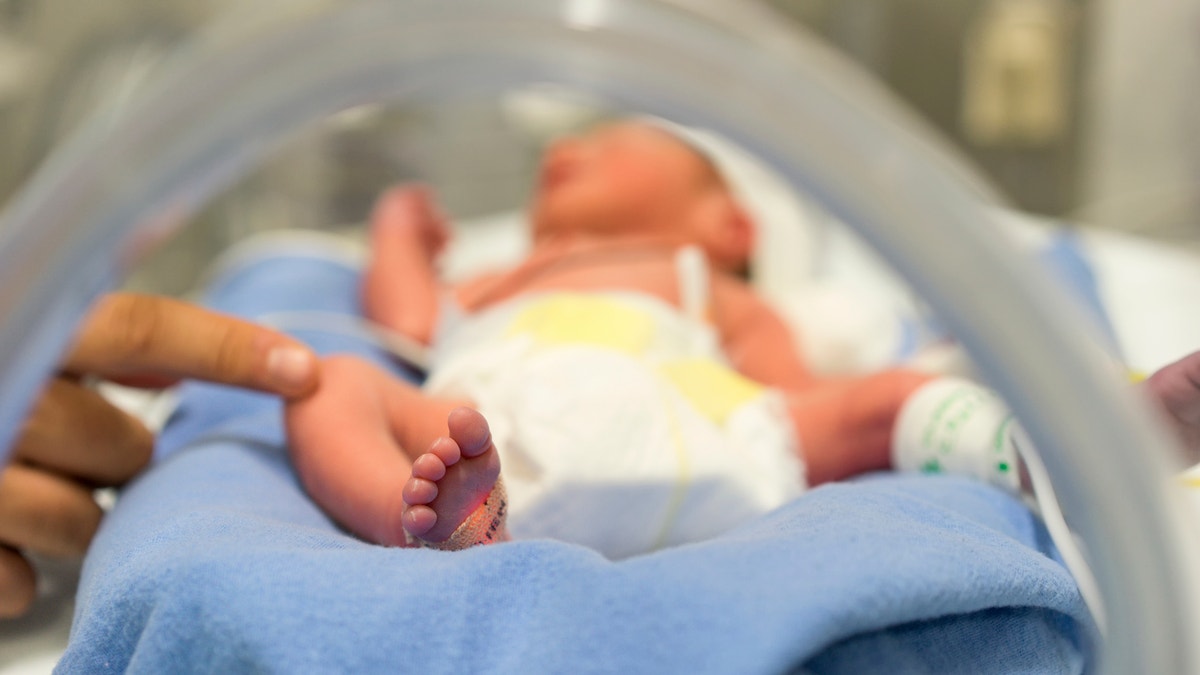
Photo of a premature baby in incubator. Focus is on his feet and toes. The doctor is touching him to check his reflexes. There are cables and tubes in the out-of-focus area. (Pixelistanbul)
In the United States, one in 10 babies are born premature, or between 20 and 37 weeks. A full term of pregnancy is at least 40 weeks.
Preterm babies are not only smaller than their full-term counterparts, but they can have a wide range of physical and developmental problems. Those babies who are delivered between 23 and 28 weeks in particular have the highest risk of complications such as cerebral palsy, ADHD, anxiety, asthma, and problems with vision, hearing and digestion.
They also have a higher risk of infections and are most at risk for Sudden Infant Death Syndrome (SIDS).
“As you get further along in gestation those risks decrease,” Dr. Jill Hechtman, medical director of Tampa Obstetrics in Tampa, Florida said.
Factors like obesity, smoking, alcohol and drug abuse and limited access to prenatal care can put a woman at an increased risk for preterm birth. Women who have high blood pressure, preeclampsia, diabetes or blood clotting disorders and women who are pregnant with a baby who has certain birth defects are also at risk.
Yet for many women, the specific risk factors aren’t so clear. In fact, two-thirds of premature births have no known biological a recent study of high-income nations published in the journal PLOS ONE found.
Nevertheless, experts say there are some risk factors that could potentially increase your risk for having a preemie.
1. Personal history
The most important risk factor for preterm birth is a prior history of having a premature baby, Hechtman said. In fact, studies show women who previously had a preterm birth are between 30 to 50 percent likely to have a subsequent one.
2. Birth spacing
Studies show pregnancies that are close together can increase the risk for preterm birth. In fact, more than half of women who became pregnant after 12 months of giving birth delivered their next baby before 39 weeks, a study in BJOG: An International Journal of Obstetrics and Gynaecology found.
Experts say the optimal time between pregnancies is 18 months but that it’s not clear why and that more research is needed.
“But the numbers do tell the story that for every month that you get closer to that 18 months in between pregnancies, the higher likelihood that you will have a healthy pregnancy,” said Dr. Scott D. Berns president and CEO of the National Institute for Children's Health Quality (NICHQ) in Boston, Massachusetts.
3. IVF
More women than ever are turning to in-vitro fertilization (IVF) to get pregnant. In 2014, 375 member clinics of the Society for Assisted Reproductive Technology (SART) performed 190,384 IVF cycles and related procedures which resulted in 65,175 babies delivered. Although it’s not clear why, women who conceive through IVF seem to have an increased risk for preterm birth.
4. Twins or multiples
Premature birth is the most common complication for women pregnant with twins or multiples. In fact, 50 percent of twins, 90 percent of triplets and almost all quadruplets or higher multiples are premature, according to the March of Dimes.
5. Shortened cervix
Women who have a shortened cervix after undergoing the loop electrosurgical excision procedure (LEEP) procedure— which tests for pre-cancerous or abnormal cells— have an increased risk.
6. Depression
Mothers who had both new and recurrent depression had a 30 to 40 percent increased risk of preterm birth between 32 and 36 weeks, while a new depression in fathers was associated with a 38 percent increased risk of preterm birth between 22 and 31 weeks, according to a study in BJOG: an International Journal of Obstetrics and Gynaecology (BJOG).
7. Underweight
Although nearly half of women gain too much weight during pregnancy, 21 percent do not gain the recommended amount, according to a study in the journal Obstetrics and Gynecology. And that alone can increase your chances. Although you don’t want to “eat for two,” a healthy diet and the right amount of exercise might be one way to prevent prematurity.
8. Infections
Infections such as bacterial vaginosis or those due to certain bacteria such as mycoplasma and ureaplasma can increase your risk. Group B streptococcus is a less common risk factor so even if you test positive for it in late pregnancy, it doesn’t mean you will have a preterm birth, Hechtman said.
9. Air pollution
Sixteen thousand preterm births have been linked to air pollution in the U.S., according to a study by NYU Langone Medical Center. Those areas most affected are urban counties, primarily in southern California and the eastern U.S., with peak numbers in the Ohio River Valley.
What you should know
It’s important to talk to your doctor about your individual risk factors for having a preemie so you can make lifestyle changes and prepare in case your baby comes early.
Also, ask your doctor about the new PreTRM test, the first and only blood test that determines a woman’s risk for a spontaneous, early delivery. The test, which is drawn during the 19th or 20th week of pregnancy, looks at two types of proteins that have been shown to be effective predictors for women at risk for preterm delivery, a study in the American Journal of Obstetrics and Gynecology found.
Since the test is done early, it can potentially help your doctor decide on additional screening and treatments used for women who have had a previous preterm delivery in order to prevent serious complications.
“Every 24 hours in pregnancy makes a difference,” Hechtman said.
Worrying about every potential risk factor isn’t necessary or helpful for a happy, stress-free pregnancy. Instead, eat healthy, exercise, keep up with your prenatal visits and find time to relax and have fun.
